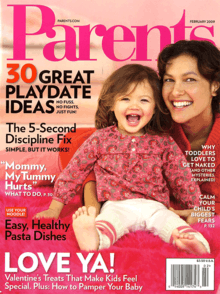Parents (magazine)
 | |
| Editor in Chief | Dana Points |
|---|---|
| Categories | Parenting |
| Frequency | Monthly |
| Publisher | Meredith Corporation |
| Total circulation (2011) | 2,215,645 |
| First issue | October 1926 |
| Country | United States |
| Based in | New York City[1] |
| Language | English |
| Website |
www |
| ISSN | 1083-6373 |
Parents, published by Meredith Corporation, is an American mass circulation monthly magazine that features scientific information on child development geared to help parents in raising their children.
History
The magazine started by George J. Hecht in 1926, and he hired Clara Savage Littledale to be its first editor. The first issue was published in October 1926[2][3] and soon was selling 100,000 copies a month.[4] Littledale was followed as editor by Mary Buchanan.
From 1941–1965, Parents Magazine Press published a line of comic books and magazines heavily featuring comics, including such long-running titles as Calling All Girls, Children's Digest, Polly Pigtails, True Comics, and True Picture-Magazine.[5] Parents Magazine Press also published Humpty Dumpty from the 1950s through the early 1980s, until it and Children's Digest were sold to the Saturday Evening Post company.
Parents magazine was sold to Gruner + Jahr in 1978, at which time Elizabeth Crow became the magazine's editor for the next decade.
Meredith acquired the magazine when Gruner + Jahr left the US magazine business in 2005. Sally Lee was the editor from 1998 to 2008. Dana Points has been Editor in Chief since 2008.
Profile
Its editorial focus is on the daily needs and concerns of mothers with young children. The glossy monthly features information about child health, safety, behavior, discipline and education. There are also stories on women's health, nutrition, pregnancy, marriage, and beauty. It is aimed primarily at women ages 18–35 with young children.
Columns include "As They Grow," which cover age-specific child development issues, as well as the reader-generated "Baby Bloopers," "It Worked for Me," and "Goody Bag." The magazine also produces a website,[6] an iPhone app for kids, Parents Flash Cards, and GoodyBlog.com, the now-defunct blog.
With its impressive historical reach, Parents has frequently been used by academics, to document social and cultural shifts over time. Melissa Milkie and Kathleen Denny describe the prominence of the magazine:
The magazine's goal of disseminating scientific knowledge of all types concerning children's development and family life in general, proved to be very popular. The magazine was the only U.S. periodical whose circulation rose during the Great Depression, and during the 1930s and 1940s, it was proclaimed as the most popular advice periodical in the world (Schlossman, 1985).[7] By 1971, PM claimed in its pages to have counseled mothers and fathers in the 'rearing of more than 100 million children,' attesting to its prominence"[8]
Despite its gender-neutral title, the magazine's advice has implicitly been directed toward women.[9]
References
- ↑ Dave Eisenstadter (May 28, 2015). "Family Fun magazine leaving Northampton; jobs moving to New York City". GazetteNet. Retrieved December 12, 2015.
- ↑ "Magazines in Alphabetical Order". Radcliffe Institute. Retrieved October 19, 2015.
- ↑ "Top 100 U.S. Magazines by Circulation" (PDF). PSA Research Center. Retrieved February 6, 2016.
- ↑ Selig, Diana. "Parents Magazine". Encyclopedia of Children and Childhood in History and Society. Retrieved December 12, 2011.
- ↑ Parents Magazine Press, Grand Comics Database. Accessed Feb. 29, 2016.
- ↑ "Parents". parents.com. Retrieved December 12, 2011.
- ↑ Schlossman, S. (1985) Perils of Popularization: The founding of Parents' Magazine. Monographs for the Society for Research in Child Development, 50, 65-77.
- ↑ Milkie, M. and K. Denny (2014) Changes in the Cultural Model of Father Involvement: Descriptions of Benefits to Fathers, Children, and Mothers in Parents' Magazine, 1926-2006. Journal of Family Issues, 35:223-53.
- ↑ Strathman, T. (1984). From the quotidian to the utopian: Child rearing literature in America, 1926-1946. Berkeley Journal of Sociology, 29, 1-34.